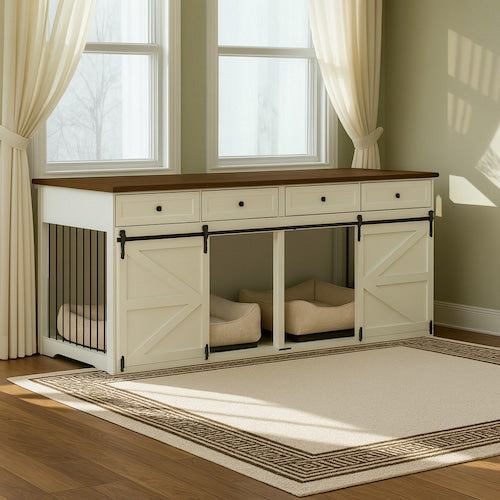Difference Between No Pull Harness And Regular Harness
As devoted dog owners, we know the joy and companionship our furry friends bring to our lives. However, the daily struggle of dealing with a dog that pulls during walks can sometimes put a damper on this experience. In this comprehensive guide, we'll delve into the world of harnesses and compare the pros and cons of no pull harnesses versus regular harnesses, aiming to help fellow dog parents choose the best gear for their beloved companions.

Understanding the Basics
Being responsible dog owners, we want to start by understanding the basics of the gear we use. Let's delve deeper into the key distinctions between a no pull harness and a regular harness.

Regular Harness: A regular harness is a traditional piece of gear designed to be worn around a dog's torso. It typically consists of straps that encircle the chest and back, with a leash attachment point located on the dog's back. The primary purpose of a regular harness is to distribute pressure evenly across the dog's body, particularly around the chest and shoulders.
The even distribution of pressure serves several purposes:
- Reduced Neck Strain: Unlike collars that put direct pressure on the neck, a regular harness helps mitigate strain on the neck, preventing potential injuries that could occur if a dog were to pull on the leash.
- Controlled Movement: By providing a point of attachment on the back, regular harnesses offer dog owners better control over their pets during walks, discouraging pulling behavior.
No Pull Harness: A no pull harness, as the name suggests, is specifically designed to address the issue of pulling during walks. These harnesses often feature unique design elements that work to discourage pulling instincts in dogs. Here are some common features of no pull harnesses:

Click Here for 50% Off Our #1 Rated COMMANDER No Pull Harness and Take Control Today!
-
Front Attachment Point: One of the defining features of a no pull harness is the leash attachment point located at the front of the chest, rather than on the back. This strategic placement redirects a dog's attention towards the owner when they attempt to pull, encouraging them to walk beside rather than ahead.
-
Tightening or Pressure Mechanism: Some no pull harnesses incorporate a tightening or pressure mechanism that activates when the dog pulls. This slight discomfort serves as a deterrent, teaching the dog to walk without pulling to avoid the sensation.
-
Training Accessories: No pull harnesses may come with additional training accessories, such as a dual-clip system allowing the owner to choose between front and back attachment points based on the dog's behavior and training progress.
The Mechanics of Pulling
Let's face it, dogs pull – it's in their nature! Understanding why dogs tug on their leash during walks is crucial to addressing the behavior and choosing the right gear. Dogs pull on the leash for various reasons, and a regular harness might inadvertently contribute to or reinforce this behavior.
How does a No Pull Harness Work Exactly?
The front-clip changes the point of leverage because the leash is attached to the front of the dog. If they pull the effect is that the leash gives a tug on their chest to the side, therefore turning the dog toward you and not allowing them to move forward. So if they pull, they get turned. And if they turn, they aren’t heading forward which is where they want to be going and why they are pulling.

Click Here for 50% Off Our #1 Rated COMMANDER No Pull Harness and Take Control Today!
Reasons Dogs Pull on the Leash:
-
Natural Instincts: Dogs have an innate instinct to explore their environment, which involves moving forward and investigating scents. This natural curiosity can lead to pulling as they attempt to move ahead of their owner.
-
Excitement: Dogs are social animals, and the anticipation of a walk or encountering new stimuli can trigger excitement. This excitement may manifest as pulling, especially if the dog is eager to reach a particular destination.
-
Lack of Training: Some dogs may not have been properly trained to walk on a leash without pulling. Without clear guidance and consistent training, they may develop the habit of pulling as a way to lead the way.
Now, let's explore how a regular harness might unintentionally encourage pulling behavior:

Ways a Regular Harness May Contribute to Pulling:
-
Back Attachment Point: Most regular harnesses have a leash attachment point on the back. While this positioning provides control, it can also allow the dog to pull with more strength. The back attachment point doesn't provide as much leverage for redirecting the dog's attention.
-
Lack of Discouragement: Traditional harnesses are designed to evenly distribute pressure, but they may not actively discourage pulling. If a dog is not trained to walk politely on a leash, the even pressure distribution may not provide sufficient feedback to deter pulling behavior.
-
Unintentional Reinforcement: Owners may unintentionally reinforce pulling behavior by allowing the dog to move forward when pulling occurs. If the dog learns that pulling leads to getting where they want to go, they are more likely to continue this behavior.
By understanding these dynamics, dog owners can make informed decisions when choosing between a regular harness and a no pull harness. The key is to select a harness that aligns with the dog's behavior, training needs, and the owner's preferences for a more enjoyable walking experience.

The Benefits of No Pull Harnesses
One of the primary concerns we have as dog parents is our pet's well-being. No pull harnesses come to the rescue by reducing strain on our dog's neck, preventing potential injuries. These harnesses are also designed to discourage pulling, making our daily walks more enjoyable for both us and our four-legged pals.
Other Benefits Include:
-
Enhanced Control: No pull harnesses often feature front attachment points, strategically placed on the chest. This positioning provides dog owners with improved control over their pets' movements, making it easier to guide and redirect them during walks.
-
Prevention of Escaping: Some dogs are master escape artists, slipping out of their collars or harnesses. No pull harnesses typically offer a more secure and snug fit, reducing the risk of your dog slipping out and ensuring a safer walking experience.
-
Comfortable Padding: Many no pull harnesses come with added padding in key areas, such as the chest and straps. This padding not only enhances comfort for your dog but also reduces the likelihood of chafing or irritation, particularly during more extended walks.
-
Versatility in Training: No pull harnesses can be valuable tools in training your dog to walk politely on a leash. With consistent use, these harnesses can contribute to positive behavior reinforcement, encouraging your dog to adopt better leash manners over time.
-
Reflective Elements for Safety: Several no pull harnesses come equipped with reflective materials, enhancing visibility during low-light conditions. This added safety feature ensures that you and your dog remain visible to passing vehicles and pedestrians, reducing the risk of accidents.
- Customizable Fit: Many no pull harnesses are adjustable, allowing you to achieve a customized fit tailored to your dog's size and body shape. This adaptability ensures maximum comfort and effectiveness, regardless of your dog's breed or build.

Click Here for 50% Off Our #1 Rated COMMANDER No Pull Harness and Take Control Today!
Training Considerations
While no pull harnesses often offer quicker results and a more positive walking experience, it's important to emphasize that they should be used in conjunction with regular training for the best and most lasting results. Being good pet parents means being good trainers, and combining the benefits of a no pull harness with consistent training ensures a harmonious walking experience for both you and your furry friend.
Final Thoughts
As we wrap up our journey through the leash struggle, let's remember that the key lies in choosing the harness that best suits our dog's unique needs. Whether it's the even pressure distribution of a regular harness or the pulling deterrent features of a no pull harness, the goal is to enhance our walking experience and keep our furry friends safe and happy.
By sharing insights and experiences, we hope to guide our fellow dog parents through the harness dilemma and make the right choice for their cherished companions. After all, a happy dog makes for a happy owner!
For more products to keep your dog happy and healthy, explore our selection here. You can also find valuable resources for you and your dog on our Pet Parent Resources Page






Leave a comment